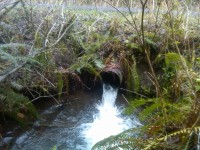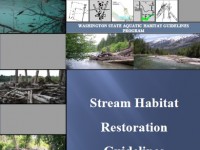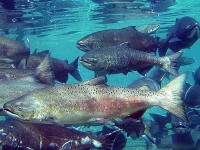www.ChehalisLeadEntity.org
News

Call for Proposal: 2016 SRFB Grants
Call for Proposal: 2016 SRFB Grants
Would you like to see thriving salmon populations in our local rivers and streams? Do you have an idea for a salmon habitat restoration project in your community? If so, you will be pleased to know that the Chehalis Basin Lead Entity is soliciting applications for 2016 grant year.
What is a salmon habitat restoration project?
Salmon habitat restoration can occur in many ways.
 The most common restoration actions that have taken place in the Chehalis Basin over the past few decades have been culvert corrections. Undersized and poorly constructed culverts impede salmon passage, making it impossible for an adult salmon to access spawning habitat, or for a juvenile salmon to access feeding areas. By correcting barrier culverts, we allow a stream to fully use its channel and salmon to fully use their habitat.
The most common restoration actions that have taken place in the Chehalis Basin over the past few decades have been culvert corrections. Undersized and poorly constructed culverts impede salmon passage, making it impossible for an adult salmon to access spawning habitat, or for a juvenile salmon to access feeding areas. By correcting barrier culverts, we allow a stream to fully use its channel and salmon to fully use their habitat.
Other types of projects that benefit salmon include planting native vegetation along degraded stream banks, reconnecting side-channels with a river main stem, placing tree trunks and large branches in creeks, creating in-stream pools and removing invasive plant species from streambanks. Acquisition of land containing key habitats that are either in pristine condition or could benefit from restoration are also eligible for these grants.
 To access a wealth of information on what a salmon habitat restoration project can look like and what it takes to develop one, see the Salmon Habitat Restoration Guidelines document (WDFW, 2012)
To access a wealth of information on what a salmon habitat restoration project can look like and what it takes to develop one, see the Salmon Habitat Restoration Guidelines document (WDFW, 2012)
How much funding is available for projects?
The minimum amount of funding eligible applicants can apply for is $5,000. There is no maximum, but the total amount available for all projects in the river basin is approximately $500,000. Each grant needs to be “matched” with other funds, equivalent to 15% of the total project cost.
How do I apply?
To apply, eligible applicants must submit a project form to the Chehalis Lead Entity by April 1st, 2016. Prospective applicants are encouraged to contact the Lead Entity Coordinator, Kirsten Harma, at kharma@chehalistribe.org, to discuss their project idea.
To learn more about who is eligible to apply for funding, what kinds of projects are eligible, and other details, visit For Grant Applicants. Click here to download grant application materials directly from the RCO website.
 The Chehalis River and its tributaries are home to four species of anadromous salmon and two species of native trout. Unlike other parts of the state, no salmonids in the Chehalis are ESA listed as Endangered. Our rivers and streams hold great long-term potential for sustaining wild salmon runs. None-the-less, these habitats have been degraded through land use changes, resulting in significant declines in salmon populations from historic levels. To help salmon populations thrive, we need your help.
The Chehalis River and its tributaries are home to four species of anadromous salmon and two species of native trout. Unlike other parts of the state, no salmonids in the Chehalis are ESA listed as Endangered. Our rivers and streams hold great long-term potential for sustaining wild salmon runs. None-the-less, these habitats have been degraded through land use changes, resulting in significant declines in salmon populations from historic levels. To help salmon populations thrive, we need your help.
** ** ** **
Details from the State:
“2016 Grant Round
Upcoming Application Workshop
Recreation and Conservation Office (RCO) staff will host an application workshop on March 8th from 10 am – 12 pm. You can view this webinar from your desk and take the opportunity to ask questions. For more information and for workshop registration, please click on the following link: Salmon Grants Application Workshop Registration. RCO will post recordings of the workshop to the website.
Successful Applicant Workshop (for those with new SRFB grant contracts) This PowerPoint presentation walks you through RCO policies and expectations to help you manage your SRFB grant. It complements the information provided in Manual 18 Section 6, Managing Your SRFB Grant. You can view or download the workshop from: Successful Application Workshop. Please scroll down to find the Application Workshop PowerPoint presentations.
Where to Find SRFB Grant Application Materials?
Go to the Salmon Recovery Section of RCO’s Grant Application Materials Website http://www.rco.wa.gov/doc_pages/app_materials.shtml. Here you will find RCO Manual 18, Salmon Grants, all required grant application forms and project proposals, templates for cost estimate spreadsheets, application checklists, landownership and stewardship forms, Limit 8 Streamlined ESA forms, and grant training PowerPoints.
Manual 18 Salmon Recovery Grants
The 2016 Manual 18 for Salmon Recovery Grants is now available on the Recreation and Conservation Office’s (RCO) website. Please note there is a grant timeline at the front of the manual, however, applicants should check with the local salmon lead entity for their schedule and process to submit a proposal as it may differ. All needed application forms and project proposals are included in Manual 18. Here is the link to Manual 18: http://www.rco.wa.gov/documents/manuals&forms/Manual_18.pdf .
What’s New this Year?
* RCO will now allow Indirect Costs, using an approved indirect rate, for project grants that have a federal source of money associated with them (most SRFB grants). Learn more about the three options available to sponsors who are interested in requesting an indirect rate for projects. See information on the new Federal Omni Circular rules here.
* All projects now require a Grant Application Authorizing Resolution approved by the sponsor’s governing body, along with a signed Authorization Form, for each project, attached to PRISM, and due at final application submission.
* Recent changes to the streamlined federal permitting process may affect your project schedule and costs. Learn more about how to prepare for projects that typically require US Army Corps (Nationwide) and NOAA (Limit 8) streamlined permit processes.
* An updated Manual 18 that includes all of these new options and requirements.
Key Sections of Manual 18 for Applicants The manual intends to inform you of the grant round schedule, eligible applicants, and eligible project types, as well as how to apply, what to expect during the review process, and what to know about managing your grants once awarded funding. Don’t let the size scare you!!-most of it is appendices. Key sections of the documents that we highly recommend you read include:
Section 2 Eligible Applicants and Projects
Eligible project types include: – Acquisition (both fee simple and easements)
– Restoration (including stand-alone riparian stewardship)
– Assessment/Planning/Design grants with match
– Design projects without match (these must meet certain criteria to be eligible)
– Fish Barrier Inventories
– Combination acquisition and restoration OR acquisition and planning projects
Section 3 How to Apply
Section 3 provides instructions and a complete list of required deliverables to include with both the draft and final applications (note that the local lead entity may have additional requirements but, at a minimum, you must provide everything listed in Section 3). Section 3 includes tips for avoiding common mistakes and a checklist to help you stay on track. This is the most critical section to know if you plan to apply in order to avoid frantic last minute work. Remember there is little time to make changes and corrections to your applications between the date of submission and the date RCO staff need to forward complete applications to the review panel. It is important for you to submit clear and complete applications or you run the risk of last minute corrections or rejection of your application.
Section 6 Managing your SRFB grant
Get familiar with RCO policies and expectations for managing a SRFB grant before you apply to avoid surprises. Section 6 discusses the steps involved in developing your project agreement, how to manage your SRFB grant, restoration and acquisition grant policies, reimbursement information, streamlined ESA consultation for SRFB projects, progress reporting, required project deliverables, and links to helpful toolkits, checklist, and references. Once you’ve been awarded a grant, Section 6 is a good reference tool as you move forward with your project.
Appendix K: SRFB Review Panel Evaluation Learn what the review panel looks for when evaluating projects for their technical merit.
Please note, you can find your salmon grant manager on the RCO website at this link:
http://www.rco.wa.gov/maps/contact_salmon_mgr.shtml
Thank you!”
